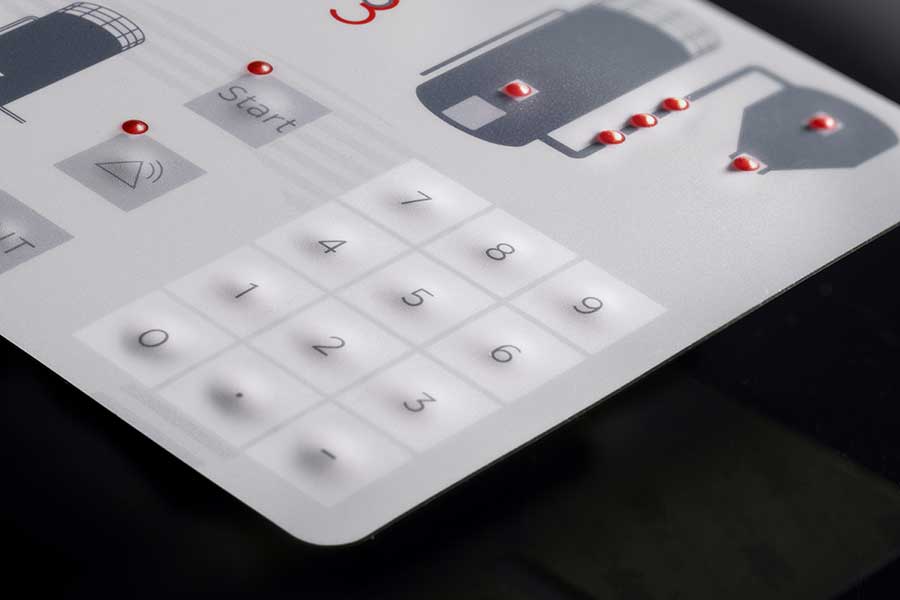Why Membrane Switches Are Essential for Long Lasting Control Solution
Membrane layer switches play a critical duty in making sure the toughness and integrity of control systems across numerous sectors. Their special building and construction permits them to sustain challenging environmental elements such as humidity, temperature level extremes, and physical wear. This durability not just extends the life-span of the systems they offer but likewise minimizes maintenance needs. As we check out the complex benefits of membrane layer switches, it ends up being apparent that their relevance transcends simple performance, influencing customer experience and operational efficiency. What more implications do these characteristics hold for the future of control system layout?
Overview of Membrane Layer Switches
Membrane layer switches are functional and reputable components typically utilized in numerous digital control systems. These switches consist of numerous layers, including a visuals overlay, a spacer layer, and a printed circuit layer. The visuals overlay offers both functional and aesthetic layout, while the spacer layer makes sure that the switches are activated just when pushed. The printed circuit layer includes conductive traces that finish an electric circuit when the membrane layer is pushed, making it possible for the gadget to react to individual inputs.
Membrane switches are usually favored in applications needing a portable and lightweight design, making them perfect for handheld gadgets, clinical equipment, and commercial machinery. They can be customized to satisfy details user demands and can integrate numerous attributes such as backlighting, tactile responses, and multiple shades. Membrane layer switches are resistant to dirt, wetness, and impurities, making them ideal for environments where resilience is crucial.
Advantages of Toughness
In several applications, the resilience of membrane layer switches offers considerable benefits that enhance their overall performance and reliability. These switches are designed to endure severe atmospheres, making them optimal for use popular problems such as high moisture, severe temperature levels, and direct exposure to chemicals. Their durable building assists to stop damage from physical impact, ensuring long-lasting capability and minimizing the demand for regular replacements.
Furthermore, membrane switches are immune to put on and tear, which is vital in applications where constant communication happens. This resilience translates to decrease upkeep prices, as companies gain from reduced downtime and fewer service interruptions. Furthermore, the encapsulated layout of membrane layer switches protects inner components from dirt and dampness access, additional contributing to their life-span.
Another advantage is their ability to preserve regular performance with time. With a high resistance for mechanical stress, these buttons protect their responsive responses and electric honesty, making certain user fulfillment. Eventually, the longevity of membrane switches over not only boosts operational effectiveness but additionally promotes self-confidence in their dependability, making them a preferred selection for control systems across different fields.
Applications in Various Industries
Sturdy control systems employing membrane buttons find comprehensive applications throughout a variety of sectors, each gaining from the special characteristics these buttons supply. In the medical market, membrane layer switches are critical for gadgets such as individual displays and analysis tools, where integrity and ease of cleaning are extremely important. Their resistance to moisture and pollutants guarantees they maintain functionality in sterilized atmospheres.
The auto industry leverages membrane buttons for dashboard controls and infotainment systems, where they offer smooth, inconspicuous user interfaces that boost user experience. These switches are also developed to stand up to extreme problems, including direct exposure to severe temperatures and vibrations.
In commercial setups, membrane layer buttons are frequently made use of in equipment control panels, providing tactile responses and toughness necessary for high-usage applications. Their ability to withstand chemicals makes them appropriate for making environments where spills and pollutants are regular.

Consumer electronics, such as kitchen appliances and remotes, additionally make use of membrane layer buttons for their adaptability and cost-effectiveness. In general, the versatility and robust nature of membrane layer switches over make them vital across various sectors, making certain effective operation and durability in control systems.
Design and Aesthetic Appeal
While capability is critical, the layout and aesthetic charm of control systems outfitted with membrane layer buttons play a vital function in user involvement and general experience (membrane switch). The visual layout of these switches can significantly affect individual understanding and interaction. A well-designed membrane layer switch improves the good looks of the gadget, making it more attractive to users and cultivating a link between the customer and the product
Membrane switches over offer a large amount of flexibility in layout, enabling manufacturers to tailor graphics, colors, and appearances to line up with brand name identity and product appearances. Using vibrant shades and distinctive patterns can draw focus, while tactile comments can reinforce the individual's communication with the device. In addition, the ability to incorporate LED indicators and backlighting into the membrane button style provides both practical and visual advantages, enhancing exposure and use in various atmospheres.

Enhancing User Experience

Additionally, membrane switches can be customized to integrate graphical interfaces, enhancing usability by presenting information in a clear and user-friendly way (membrane switch). This personalization can include icons, labels, and color coding that guide individuals with facility capabilities easily. Additionally, their versatility enables assimilation in numerous settings, making certain regular efficiency whether in industrial machinery or consumer electronic devices
The durability of membrane switches additionally plays click for more a critical duty in individual experience. By enduring harsh problems and extended usage, these buttons minimize the likelihood of system failures, thus advertising reliability and individual self-confidence. Ultimately, the critical usage of membrane switches not only elevates capability however likewise substantially enriches user Your Domain Name communication with control systems, making them a crucial part in contemporary design.
Verdict
